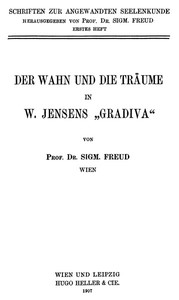Der Wahn und die Träume in W. Jensens »Gradiva« by Sigmund Freud
"Der Wahn und die Träume in W. Jensens »Gradiva«" by Sigmund Freud is an essay written in 1907 that applies psychoanalysis to Wilhelm Jensen's novel Gradiva. Freud examines how the protagonist, a young archaeologist named Norbert Hanold, unconsciously transforms his repressed childhood love into an obsession with a Roman relief depicting a walking woman. Through encounters in Pompeii, the archaeologist's delusions intertwine with reality until his former sweetheart herself becomes the agent
of his cure, revealing what Freud called "cure by seduction" or "cure by love." (This is an automatically generated summary.)
Read or download for free
| How to read | Url | Size | |||
|---|---|---|---|---|---|
| Read now! | https://www.gutenberg.org/ebooks/35549.html.images | 218 kB | |||
| EPUB3 (E-readers incl. Send-to-Kindle) | https://www.gutenberg.org/ebooks/35549.epub3.images | 119 kB | |||
| EPUB (older E-readers) | https://www.gutenberg.org/ebooks/35549.epub.images | 120 kB | |||
| Kindle | https://www.gutenberg.org/ebooks/35549.kf8.images | 186 kB | |||
| older Kindles | https://www.gutenberg.org/ebooks/35549.kindle.images | 168 kB | |||
| Plain Text UTF-8 | https://www.gutenberg.org/ebooks/35549.txt.utf-8 | 201 kB | |||
| Download HTML (zip) | https://www.gutenberg.org/cache/epub/35549/pg35549-h.zip | 109 kB | |||
| There may be more files related to this item. | |||||
Similar Books
About this eBook
| Author | Freud, Sigmund, 1856-1939 |
|---|---|
| Title | Der Wahn und die Träume in W. Jensens »Gradiva« |
| Note | Wikipedia page about this book: en.wikipedia.org/wiki/Delusion_and_Dream_in_Jensen%27s_Gradiva |
| Credits |
Produced by Jana Srna and the Online Distributed Proofreading Team at www.pgdp.net |
| Reading Level | Reading ease score: 60.1 (8th & 9th grade). Neither easy nor difficult to read. |
| Language | German |
| LoC Class | PT: Language and Literatures: Germanic, Scandinavian, and Icelandic literatures |
| Subject | Psychoanalysis |
| Subject | Jensen, Wilhelm, 1837-1911. Gradiva |
| Category | Text |
| EBook-No. | 35549 |
| Release Date | Mar 11, 2011 |
| Most Recently Updated | Mar 10, 2012 |
| Copyright Status | Public domain in the USA. |
| Downloads | 289 downloads in the last 30 days. |
| Project Gutenberg eBooks are always free! | |

